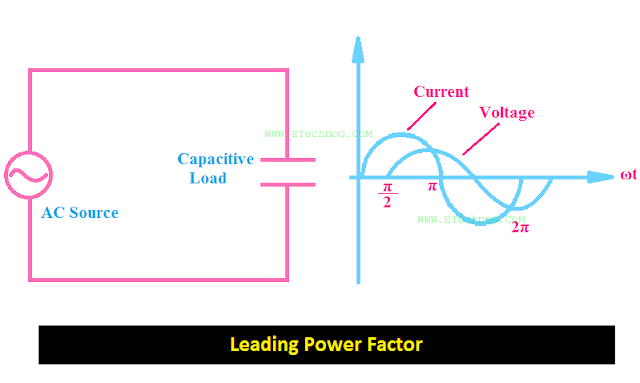Leading Power Factor Causes, Effects, Improvements
Power Factor defines the phase difference between current and voltage in an electrical circuit. In DC circuits, there is no phase difference between voltage and current that's why DC has no power factor. But in the case of AC, the power factor is very important. Reactive devices such as inductors, and capacitors create a phase difference between voltage and current when AC supply is given.
When there is no phase difference between voltage and current or in other words when voltage and current both are in the same phase, the power factor will be unity.
When the current lags behind the voltage, then the lagging power factor occurs.
When the current leads behind the voltage, then the leading power factor occurs.
Leading Power Factor
In an AC circuit, when the current leads behind the voltage and the system behaves as capacitive nature, then the power factor will be leading.
Here you can see in the below figure, a pure capacitive load is connected to the AC supply. The current leads behind the voltage with the 90-degree angle. So it is an example of a leading power factor.
Causes of Leading Power Factor
When a pure capacitive or a capacitive load is connected to an AC supply then the leading power factor occurs.
When a pure capacitive load(which does not have any resistance) is connected to an AC supply it does not take any active or real power. Only reactive power will flow in the circuit.
When a normal capacitive load(which has some resistance) is connected to an AC supply, it consumes a few active or real power and at the same time, reactive power also flows in the circuit.
In a long-distance transmission line, two adjacent conductors create a capacitive effect which is why the leading power factor occurs. In this case, the shunt reactors(nothing but inductors) are used to improve the leading power factor in a long transmission line.
Effects of Leading Power Factor
The main harmful effect of the leading power factor is, that it creates a high voltage in the circuit which can affect the load as well as the power supply circuit.
Leading power factors can damage the power source devices such as generators, alternators, etc because generators and alternators cannot withstand the leading power factor.
Leading Power causes to increase the receiving end voltage than the sending end voltage in a transmission line.
Leading Power Factor Improvement
The leading Power factor can be improved by installing an inductive load bank. Inductive load bank takes lagging power factor so it can be used for leading power factor improvement. Shunt Reactors are also used to improve the leading power factor.
Thank you for visiting the website. keep visiting for more updates.

